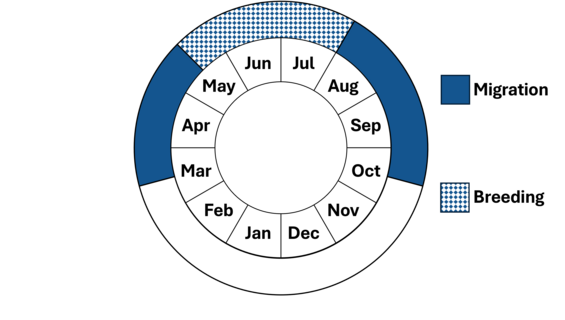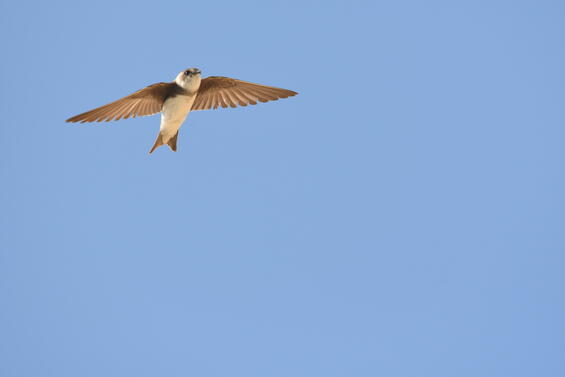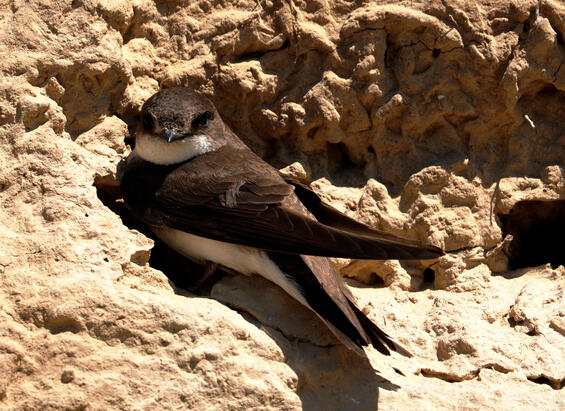- Scientific name: Riparia riparia
Species of Greatest Conservation Need (MA State Wildlife Action Plan)
Description

Bank swallow (Riparia riparia)
The bank swallow is a highly social species nesting in colonies sometimes reaching up to 2,000 nests. It is the smallest of all swallow species that nest in Massachusetts and can be found foraging for small insects over open water bodies or fields. The plumage of sexes is similar throughout the year. Adults are brown-gray above and white underneath with a distinct brown band across the breast. It is similar in appearance to the northern rough-winged swallow but can be identified by its strong breast band.
Life cycle and behavior
The bank swallow’s breeding season begins in June, several weeks after they return from their wintering grounds in South America. They are colonial nesters in steep sandy or gravelly banks. Males excavate burrows leading to a nesting chamber. Females line the chamber with straw, grass, leaves, and rootlets. Bank swallows lay 3-5 white eggs and may have 2 broods. Females do most of the incubating which takes about 13-15 days. The young fledge in about 18-21 days after hatching. Fall migration peaks in the US in August to late September when bank swallows return to South America to overwinter.

Population status
According to the Breeding Bird Survey, bank swallow populations have steeply declined in North America from 1966-2022. This includes a 5% annual decline in Massachusetts, where the distribution is dictated by the availability of adequate nesting sites. Similarly, their numbers have shown a significant decrease in Massachusetts from the first Massachusetts Breeding Bird Atlas to BBA2.
Distribution and abundance

Bank swallow (Riparia riparia)
Bank Swallows are one of the most widely distributed swallows in the world. Their North American breeding range extends from much of Alaska and Canada, and south to northern California, eastward throughout the north central United States encompassing New York, New Jersey, Pennsylvania, and New England. Bank swallows are distributed throughout Massachusetts in association with riverbanks and coastlines. Population size can vary over short time periods due to the temporary nature of nesting habitat and variable mortality on wintering grounds due to weather events.
Habitat
The bank swallow prefers to nest in the banks of rivers and streams, ocean bluffs, sandbanks, and gravel pits. These swallows rarely use artificial nesting sites, but they can benefit from human-made structures (e.g., gravel quarries). Colonies are usually associated with water bodies due mostly to adequate soil structures for nesting. They are generally not found in dense forests due to the lack of suitable nesting locations. As with other swallows, foraging occurs in open areas, such as wetlands, agricultural fields, and over open water.
Healthy habitats are vital for supporting native wildlife and plants. Explore habitats and learn about conservation and restoration in Massachusetts.

Bank swallow (Riparia riparia)
Threats
Loss of nesting habitat is often due to erosion control and water flow management, which either alters banks used for nesting or increases erosion of banks. Populations are thought to have declined in Connecticut in relation to a decrease in gravel-mining operations. Many of the aerial insectivores are now in decline, and this may be a result of a mismatch in timing between when birds are nesting and the peak abundance of their food resources. Such a mismatch is thought to be caused by climate change and has resulted in documented population declines in some species.
An additional threat to the species is collisions with buildings and other structures, as approximately 1 billion birds in the United States are estimated to die annually from building collisions. A high percentage of these collisions occur during the migratory periods when birds fly long distances between their wintering and breeding grounds.
Conservation
Conservation of bank swallows can be assisted by avoiding extraction activities in sand and gravel quarries and other vertical banks during active nesting season. Artificial nesting sites have been attempted in some locations but generally are not cost-effective and are difficult to maintain. Bird collision mortalities can be minimized by making glass more visible to birds. This includes using bird-safe glass in new construction and retrofitting existing glass (e.g., screens, window decals) to make it bird-friendly and reducing artificial lighting around buildings (e.g., Lights Out Programs, utilizing down shielding lights) that attract birds during their nocturnal migration.
References
Garrison, B. A. and A. Turner (2020). Bank Swallow (Riparia riparia), version 1.0. In Birds of the World (S. M. Billerman, Editor). Cornell Lab of Ornithology, Ithaca, NY, USA. https://doi.org/10.2173/bow.banswa.01
Sauer, J.R., J.E. Hines, J.E. Fallon, K.L. Pardieck, D.J. Ziolkowski, Jr., and W.A. Link. The North American Breeding Bird Survey, Results and Analysis 1966 – 2013. Laurel, MD: USGS Patuxent Wildlife Research Center, 2014.
Veit, R., and W.R. Petersen. Birds of Massachusetts. Lincoln, MA: Massachusetts Audubon Society, 1993.
Walsh, J., and W.R. Petersen. Massachusetts Breeding Bird Atlas 2. Massachusetts Audubon Society and Scott & Nix, Inc., 2013.
Contact
| Date published: | May 15, 2025 |
|---|